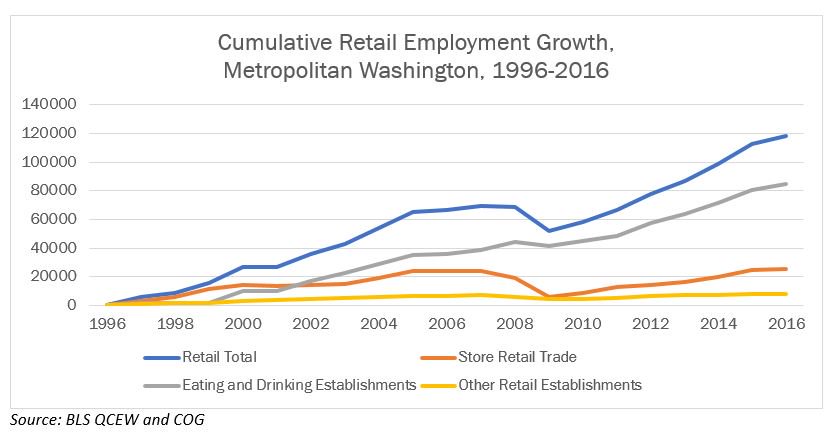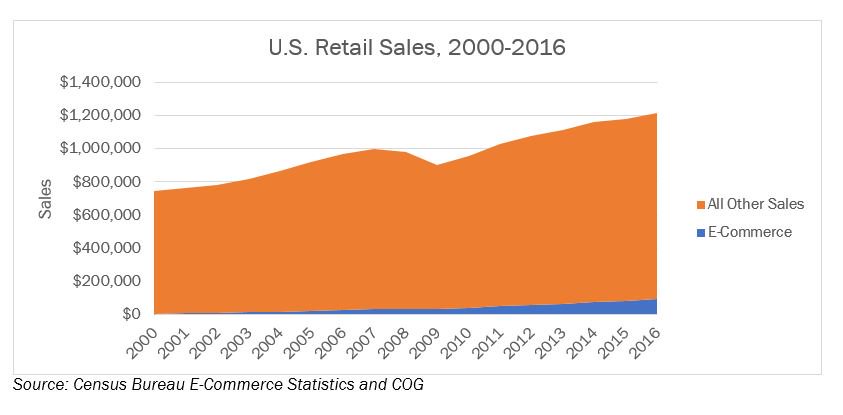With more consumers opting to shop online, there is increasing consideration to the impact that this trend will have on metropolitan Washington region’s main streets and shopping districts. Retail is an important economic contributor to jobs in the region. It includes employment at stores (such as grocery stores, sporting goods stores, and clothing stores) eating and drinking establishments (such as restaurants, bars, and coffee shops), and other retail establishments (such as auto repair shops, dry cleaners, and nail salons).
The Metropolitan Washington Council of Governments’ (COG) Cooperative Forecasting Program provides predictions about employment trends, including what retail may look like in metropolitan Washington’s future. The forecasts are used by local governments and regional and federal agencies for efforts like transportation planning and determining the demand for public facilities.
1. Overall retail employment continues to grow. Retail employment has increased at the regional level as well as in the Central Jurisdictions, Inner Suburbs, and Outer Suburbs [1]. There was a pause in growth during the Great Recession, but retail employment recovered and is increasing across metropolitan Washington.
2. Employment growth at eating and drinking establishments drives retail employment. In the early 2000s, employment at eating and drinking establishments, such as restaurants, bars, and coffee shops, began outpacing employment at stores. Over the past two decades, nearly two out of every three new retail jobs created were at eating and drinking establishments.

3. Among stores, employment at food and beverage stores dominates. Between 1996 and 2016, 81 percent of the increase in employment at stores (27,000 jobs), was at food and beverage stores (21,900 jobs), such as grocery and convenience stores. The share of store-based retail employment at food and beverage stores has increased in Central Jurisdictions, Inner Suburbs, and Outer Suburbs.
4. Although e-commerce is a relatively small part of annual U.S. retail sales, it is steadily increasing. The U.S. Census Bureau estimates that about nine percent of retail sales occurred online during the third quarter of 2017. This number includes store and online retailers in this estimate, while eating and drinking establishments as well as other retail establishments are excluded. The number is likely higher in metropolitan Washington. For example, nearly 41 percent of all adults in the Washington area are Amazon customers, which is more than any other area.

While retail employment is continuing to increase across metropolitan Washington, the increase is primarily driven by establishments that sell food to consumers. Eating and drinking establishments are driving growth in retail employment. And, food and beverage stores are driving growth in employment at stores.
Over the past two decades, retail employment has only decreased at a few types of retailers: sporting good, hobby, book, and music stores; miscellaneous store retailers; electronics and appliance stores; gasoline stations; and electronics and appliance stores. E-commerce sales may contribute to the decrease in employment at sporting good, hobby, book, and music stores; miscellaneous store retailers; and electronics and appliance stores, but not at gasoline stations. The decline in the volume of gasoline sold per day, fewer employees per establishment, and competitors with larger stations and additional amenities may contribute to the decline at gasoline stations.
While e-commerce only contributes to nine percent of total U.S. retail sales, it has been steadily growing. As more consumers are enticed to purchase products online, additional stores may be impacted. In the future, we may see our region’s retail districts increasingly dominated by restaurants, coffee shops, and other places that offer consumer experiences beyond simply purchasing a product.
[1] Central Jurisdictions: District of Columbia, City of Alexandria, and Arlington County. Inner Suburbs: Town of Bladensburg, City of Bowie, City of College Park, City of Gaithersburg, City of Greenbelt, City of Hyattsville, City of Laurel, Montgomery County, Prince George’s County, City of Rockville, City of Takoma Park, City of Fairfax, Fairfax County, and City of Falls Church. Outer Suburbs: Charles County, City of Frederick, Frederick County, Loudoun County, City of Manassas, City of Manassas Park, and Prince William County
Nicole McCall is a senior regional planner at the Metropolitan Washington Council of Governments.